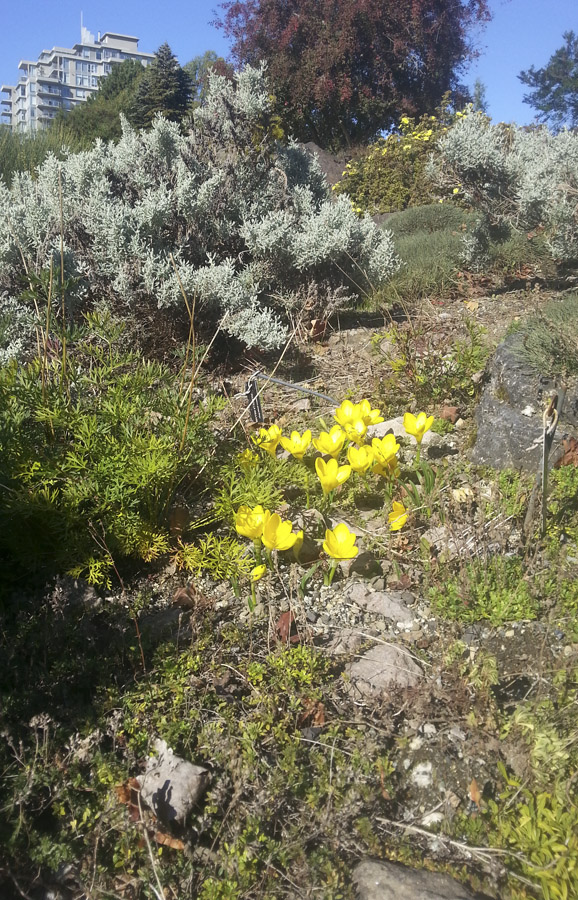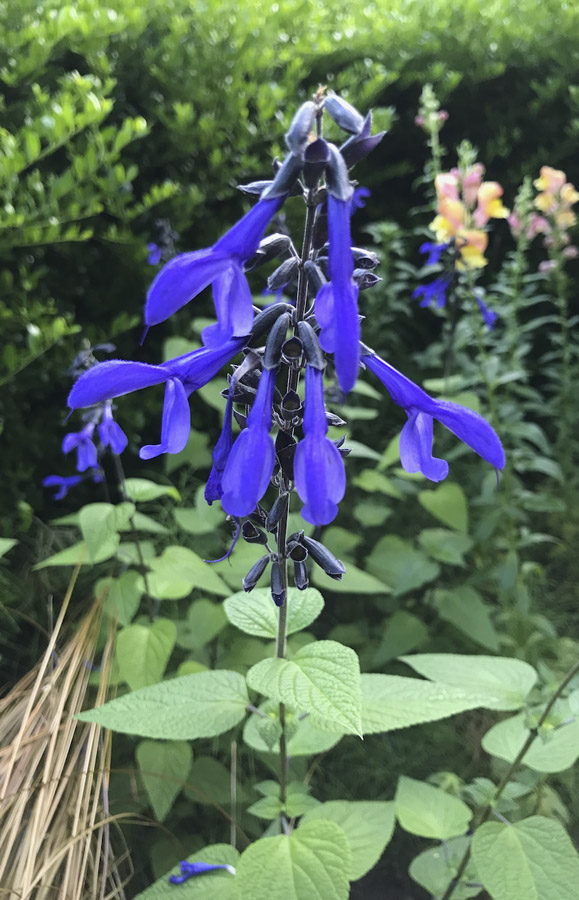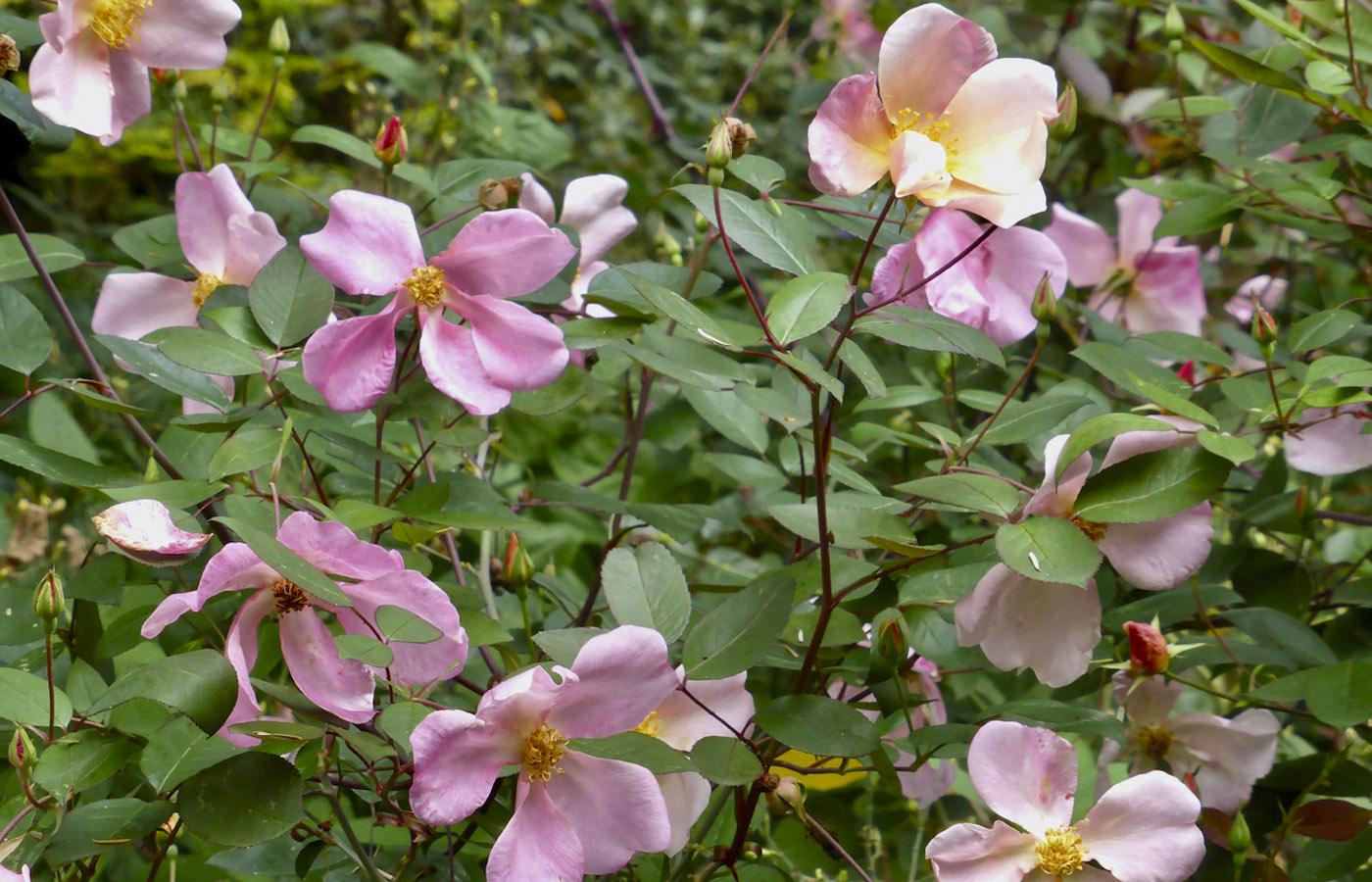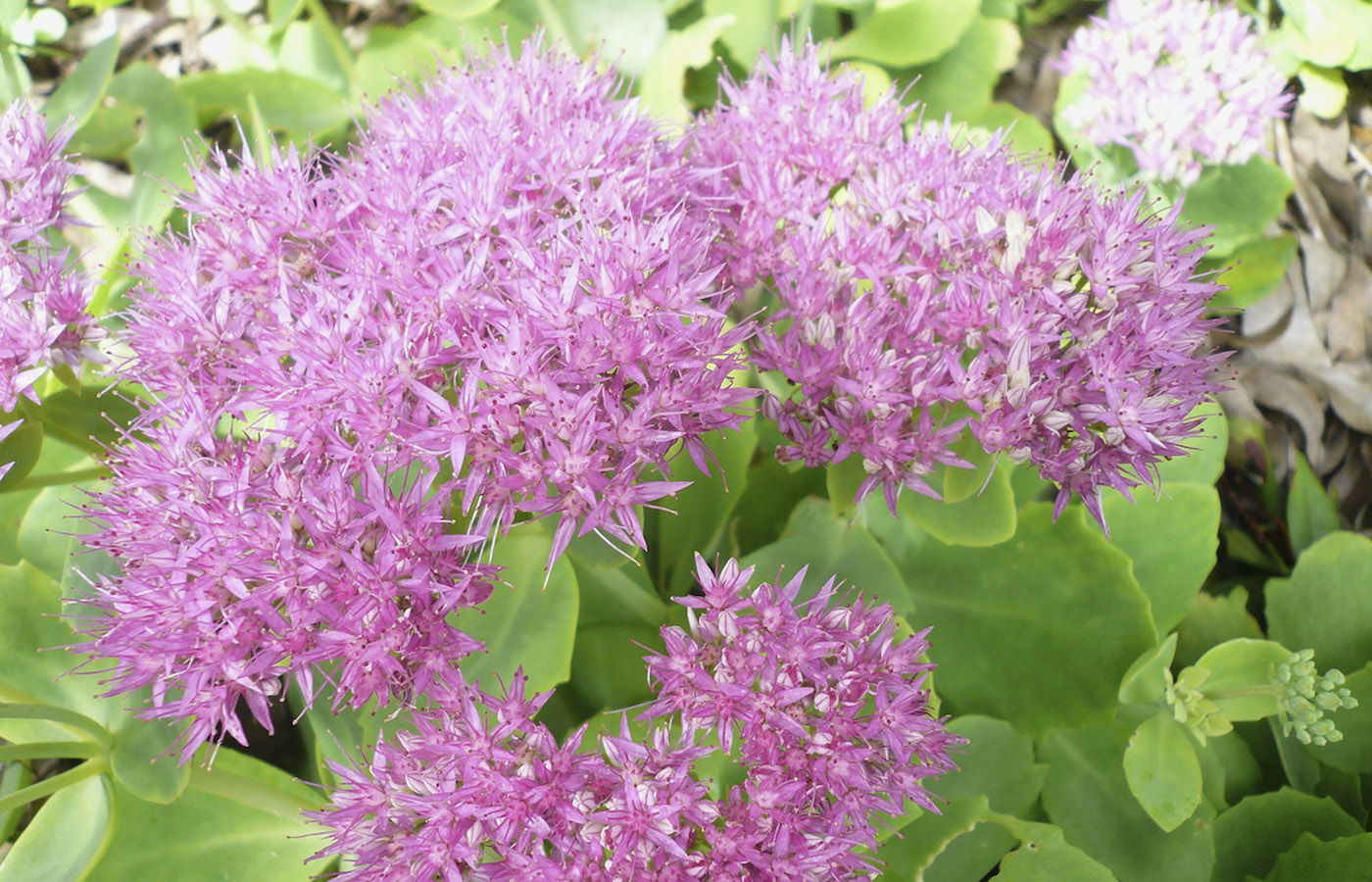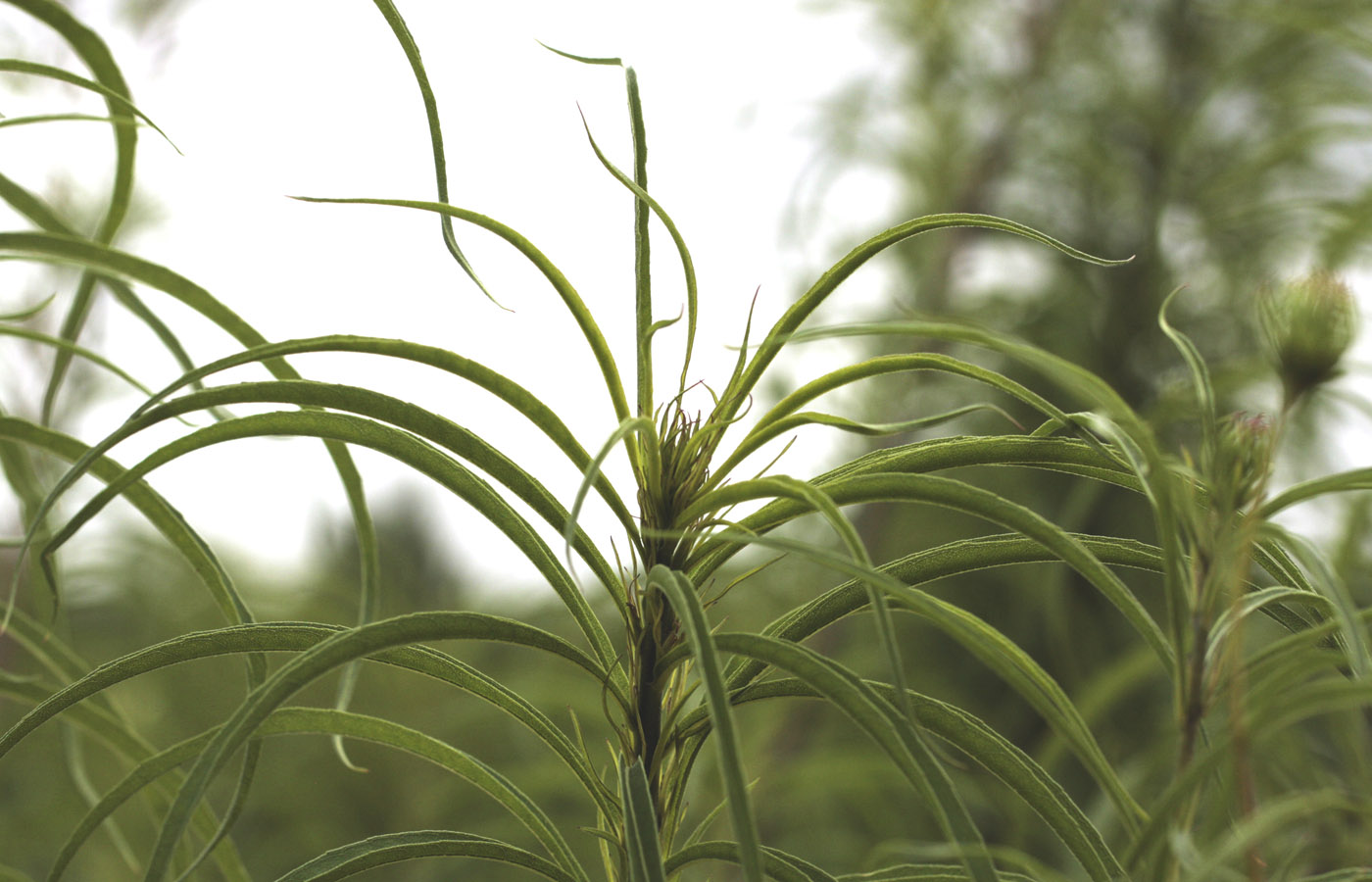For a self-guided tour, use Garden Explorer to locate plants featured in this month’s post. Select a tour in the drop-down menu.
September always feels like it’s time to get back into some kind of routine—this year, I suppose, more than ever. For those of us who are teachers or students, it’s the end of summer, the abrupt transition that signals a re-focusing on tasks that are more indoors than out.
But in the Botanical Garden, September is merely the winding down of summer, not the end. There are still plenty of flowers to see, and the fruits and berries from earlier flowers are just getting started.
Summer is the time for flowers in the plaza area at the front entrance, and this year, the unusual, willowy, narrow-leaved Helianthus angustifolius (swamp sunflower), which is native to the eastern United States, should be fully open early in September, as will the bright pink flowers of the (much lower) succulent-leaved Hylotelephium spectabile ‘Brilliant Group’. The lavender-flowered hybrid of the Asian H. spectabile and the European H. telephium, Hylotelephium ‘Herbstfreude’(Autumn Joy), sits across the plaza and opens a week or so later.
If you’re not tired of me talking about fuchsias, Fuchsia magellanica and its kin (various fuchsia hybrids) will be in their fourth month of flowering. These fuschias will, like the Salvia guaranitica ‘Black and Blue’ (anise sage) by the patio of the Reception Centre, sail right through with spectacular, hummingbird-attracting flowers well into October.
In the David C. Lam Asian Garden, look for Strobilanthes attenuata (cane-head or hardy strobilanthes) on the right just before Stearn Trail. Its opposite leaves and hooded purple flowers suggest Salvia, but its rampaging growth indicates otherwise. Strobilanthes are members of the mostly tropical acanthus family and this species, unlike any salvia, is perfectly happy forming dense colonies in shade.
In the same bed, Rosa x odorata ‘Mutabilis’ (butterfly rose) has been flowering on and off since May. If you turn the corner on to Stearn Trail and look up into the climbing stems of Actinidia deliciosa (kiwifruit) you’ll see masses of its ripening fruit hanging down. There are two or three examples of Heptacodium miconioides (seven-son flower) in the Asian Garden, all of which should be starting to bloom in September. Perhaps the best one is in the middle of Wharton Glade. This shrubby to tree-like species is renowned for its twisting stems, shredding bark and early autumn-borne, fragrant, white flowers.
The E.H. Lohbrunner Alpine Garden is always full of surprises, no matter what the season. Africa is still in its full floral blaze in September with (especially) species of Kniphofia (red-hot poker) and Dierama (angel’s fishing rods), but there are treasures in other parts of the Alpine Garden, too.
The beautiful lemon-yellow goblets of Sternbergia lutea (yellow autumn crocus) emerge from deep, underground bulbs in September, looking for all the world like, well, yellow crocuses. They are not crocuses at all (nor autumn crocuses—that would be the genus Colchicum), but members of the amaryllis family, closely related to Narcissus (daffodils). The species is native from southern Europe to Asia Minor. Reflecting this, there are small patches of S. lutea in both the Europe and Asia sections.
In the South American section, get ready for the cold-hardy pineapple relative, Fascicularia bicolor (crimson bromeliad), a Chilean native that not only has blue flowers, but leaves surrounding them that turn red, presumably to attract hummingbirds, when the flowers are ready to be pollinated.
Lastly, take a moment to explore the Carolinian Forest Garden. The burgundy red bobs of Rhus typhina (staghorn sumac) stand out on the tops of female trees in the Clayton Grove. Each conical bob is made up of scores of small, fuzzy drupes (a drupe is a fleshy fruit with a bony pit that encloses the seed—like a cherry or plum).
Nearby in the Catesby Grove is another sumac, R. aromatica (fragrant sumac). This one looks nothing like its cousin. Both are native to eastern North America, but while R. typhina is a small tree with pinnately-compound leaves that have many regular feathery leaflets, the densely shrubby R. aromatica has trifoliate-compound leaves that smell of citrus. Its drupes are in looser, less well-defined clusters and are vermillion red.
Lastly, have a look at Franklinia alatamaha (Franklin tree), also in Clayton Grove. Franklinia have been responding to the hot summers of the past few years by putting on spectacular growth and flowering heavily. Note that there’s another specimen in the plantings below the boardwalk next to the Reception Centre Patio and a third in the Bartram Gove. The American William Bartram (1739-1823) was a botanist, ornithologist, explorer, and the first European to describe Franklinia. This beautiful southeastern American camellia relative was named by Bartram for his friend, Benjamin Franklin, but was last seen in the wild in 1803 along the Altamaha River in Georgia where Bartram first discovered it.
Submitted by: Douglas Justice, Associate Director, Horticulture and Collections
- Sternbergia lutea Photo by Laura Caddy, Curator, E. H. Lohbrunner Alpine Garden.
- Sternbergia lutea Photo by Laura Caddy, Curator, E. H. Lohbrunner Alpine Garden.
- Salvia guaranitica’Black and Blue’ Photo by Douglas Justice, Associate Director (Horticulture & Collections).
- Strobilanthes attenuata Photo by Douglas Justice, Associate Director (Horticulture & Collections).
- Rosa x odorata ‘Mutabilis’ Photo by Douglas Justice, Associate Director (Horticulture & Collections).
- Rhus typhina Photo by Douglas Justice, Associate Director (Horticulture & Collections).
- Rhus typhina Photo by Douglas Justice, Associate Director (Horticulture & Collections).
- Rhus aromatica Photo by Douglas Justice, Associate Director (Horticulture & Collections).
- Hylotelephium spectabile ‘Brilliant Group’ Photo by Douglas Justice, Associate Director (Horticulture & Collections).
- Heptacodium miconioides Photo by Douglas Justice, Associate Director (Horticulture & Collections).
- Heptacodium miconioides Photo by Douglas Justice, Associate Director (Horticulture & Collections).
- Heptacodium miconioides Photo by Douglas Justice, Associate Director (Horticulture & Collections).
- Fuchsia hybrid Photo by Adriana Lopez-Villalobos, Curatorial Coordinator.
- Fascicularia bicolor Photo by Laura Caddy, Curator, E. H. Lohbrunner Alpine Garden.
- Actinidia deliciosa Photo by Douglas Justice, Associate Director (Horticulture & Collections).
- Fuchsia hybrid Photo by Adriana Lopez-Villalobos, Curatorial Coordinator.
- Fuchsia hybrid Photo by Adriana Lopez-Villalobos, Curatorial Coordinator.
- Franklinia alatamaha Photo by Douglas Justice, Associate Director (Horticulture & Collections).
- Franklinia alatamaha Photo by Douglas Justice, Associate Director (Horticulture & Collections).
- Fascicularia bicolor Photo by Laura Caddy, Curator, E. H. Lohbrunner Alpine Garden.
- Fascicularia bicolor Photo by Douglas Justice, Associate Director (Horticulture & Collections).
- Actinidia deliciosa Photo by Douglas Justice, Associate Director (Horticulture & Collections).
- Actinidia deliciosa Photo by Douglas Justice, Associate Director (Horticulture & Collections).
- Helianthus angustifolius Photo by Adriana Lopez-Villalobos, Curatorial Coordinator.
- Helianthus angustifolius Photo by Adriana Lopez-Villalobos, Curatorial Coordinator.
- Helianthus angustifolius Photo by Adriana Lopez-Villalobos, Curatorial Coordinator.
- Helianthus angustifolius Photo by Adriana Lopez-Villalobos, Curatorial Coordinator.
- Hylotelephium ‘Herbstfreude’ Photo by Adriana Lopez-Villalobos, Curatorial Coordinator.
- Hylotelephium ‘Herbstfreude’ Photo by Adriana Lopez-Villalobos, Curatorial Coordinator.

